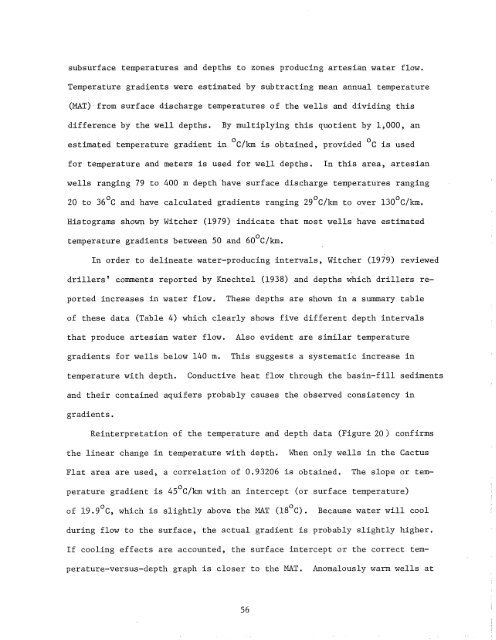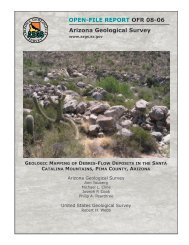geothermal resource potential of the safford-san simon basin, arizona
geothermal resource potential of the safford-san simon basin, arizona
geothermal resource potential of the safford-san simon basin, arizona
You also want an ePaper? Increase the reach of your titles
YUMPU automatically turns print PDFs into web optimized ePapers that Google loves.
subsurface temperatures and depths to zones producing artesian water flow.<br />
Temperature gradients were estimated by subtracting mean annual temperature<br />
(MAT)<br />
from surface discharge temperatures <strong>of</strong> <strong>the</strong> wells and dividing this<br />
difference by <strong>the</strong> well depths.<br />
By multiplying this quotient by 1,000, an<br />
estimated temperature gradient in °C/km is obtained, provided °c is used<br />
for temperature and meters is used for well depths.<br />
In this area, artesian<br />
wells ranging 79 to 400 m depth have surface discharge temperatures ranging<br />
20 to 36°C and have calculated gradients ranging 29 0 C/km to over l30 o C/km.<br />
Histograms shown by Witcher (1979) indicate that most wells have estimated<br />
temperature gradients between 50 and 60 o C/km.<br />
In order to delineate water-producing intervals, Witcher (1979)<br />
reviewed<br />
drillers' comments reported by Knechtel (193S) and depths which drillers reported<br />
increases in water flow.<br />
These depths are shown in a summary table<br />
<strong>of</strong> <strong>the</strong>se data (Table 4) which clearly shows five different depth intervals<br />
that produce artesian water flow.<br />
gradients for wells below 140 m.<br />
Also evident are similar temperature<br />
This suggests a systematic increase in<br />
temperature with depth.<br />
Conductive heat flow through <strong>the</strong> <strong>basin</strong>-fill sediments<br />
and <strong>the</strong>ir contained aquifers probably causes <strong>the</strong> observed consistency in<br />
gradients.<br />
Reinterpretation <strong>of</strong> <strong>the</strong> temperature and depth data (Figure 20) confirms<br />
<strong>the</strong> linear change in temperature with depth.<br />
When only wells in <strong>the</strong> Cactus<br />
Flat area are used, a correlation <strong>of</strong> 0.93206 is obtained.<br />
The slope or temperature<br />
gradient is 45 0 C/km with an intercept (or surface temperature)<br />
<strong>of</strong> 19.9 0 C, which is slightly above <strong>the</strong> MAT (lSoC). Because water will cool<br />
during flow to <strong>the</strong> surface, <strong>the</strong> actual gradient is probably slightly higher.<br />
If cooling effects are accounted, <strong>the</strong> surface intercept or <strong>the</strong> correct temperature-versus-depth<br />
graph is closer to <strong>the</strong> MAT.<br />
Anomalously warm wells at<br />
56

















